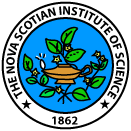
MEETINGS
MEMBERSHIP
PROCEEDINGS
ABSTRACTS
STUDENTS
LIBRARY
EXECUTIVE
BROCHURE
HALL OF FAME
HISTORY
LINKS
Monthly programmes and abstracts of meetings of the NSIS
|
1998–1999 1999–2000 2000–2001 2001–2002 |
2002–2003 2003–2004 2004–2005 2005–2006 |
Speaker List (1998–present)
3 October 2005
What's in a name -- especially if yours is mud??
Gerrard Marangoni, Department of Chemistry, St Francis Xavier University, Antigonish, NSColloid chemistry is the chemistry of substances that are 'bigger than a molecule, but smaller than the visible'. A colloid, according to Webster's dictionary, is a very fine particle that satisfies the following three criteria:
- The particle must prevent passage through a semi-permeable membrane;
- Must consist of particles which are too small for resolution with an ordinary light microscope;
- The particles fail to settle out of solution/suspension and they diffract light.
7 November 2005
Brewing Science: Advances and Challenges
Alex Speers, Food Science and Technology Program, Dalhousie UniversityIn the past 50 years, our understanding of brewing, and the science governing beer production has changed dramatically. In this presentation, the brewing process will be introduced and select areas of brewing research reviewed. In particular, current advances in yeast flocculation behaviour will be highlighted. Yeast flocculation is a key process by which yeast is removed from the newly fermented beer. This presentation will highlight the importance of antibody-like substances (zymolectins) present on the yeast cell wall that bind to mannose on adjacent yeast cells on this intriguing phenomenon. Other factors which influence the process ranging from turbulence, cell volume, zymolectin surface density and cell wall hydrophobicity will be discussed. Time permitting; advances in our understanding of beer staling and haze development will also be presented.
5 December 2005
Begging birds and the evolution of elaborate animal signals
Marty Leonard, Department of Biology, Dalhousie UniversityAnimal signals come in a diversity of forms, from the subtle whispers of mated pairs to the elaborate displays of courting males. Scientists have long been puzzled by how the displays at the showier end of the spectrum might have evolved, because these signals are energetically expensive and attract predators. Most of the research aimed at understanding the evolution of these elaborate displays has focused on signals, such as the peacock's tail, that are used in mate attraction. Elaborate signals also occur in other contexts, however. Perhaps one familiar to many is the ubiquitous screams used by young animals to solicit food from their parents. Dr. Leonard's talk will focus on these elaborate "begging" displays and how they might have evolved.
9 January 2006
Menopause, Aging, Atrophy, and Cancer in the Gynecologic Tract
Shawn Murray and Ashim Guha, Department of Pathology, Dalhousie UniversityMuch experimental research has focused on cancer development related to increased cell growth or proliferation leading to genetic mutations and eventual malignancy. Although a significant proportion of gynecologic cancers (type I) of the ovary and uterus do fit this model there is another group (type II) that occur on a background of atrophy or cell loss following the menopause. Although this dualistic model (types I & II) of cancer development likely exists in other organs it is becoming more understood within the gynecologic tract. This talk will highlight normal aging and atrophy within the gynecologic tract following the menopause and the unique pathologic features of the tumors that arise in this setting. The authors will highlight the importance of accurate diagnosis of these tumors and some potential future directions to improve both detection and treatment.
6 February 2006
Information on the move: the user perspective
Carolyn Watters, Faculty of Computer Science, Dalhousie UniversityAs information devices get smaller and smaller and internet connectivity better and better, our concept of time and place for working with data is shifting from "when I get to my office" to "right now, right here." In this talk I will discuss our current research into design issues for users of small screens. The goal of this research is to support, in particular, user performance on tasks that may involve switching between devices with large and small display areas. This involves identifying the relevant design factors and testing screen layouts and interaction designs. Three current design projects will be described in the talk: automatic transformation of web pages for small screens, design of large table functionality for small screens, and one handed input for users on the move.
6 March 2006
Integrating industrial and natural ecosystems: the possibilities
Ray Côté,School for Resource and Environmental Studies, Dalhousie UniversityOur current industrial production and consumption system is linear, extractive, and material and energy intensive. This system is not sustainable as the demands placed on the Earth from increasing population and consumption continue to grow. Conventional sources of energy and many metals will become increasingly difficult to find and costly to extract. Many scientists and industrialists have been advocating for a new industrial revolution, one which takes natural indigenous products and ecosystems as models. This presentation will explore approaches such as biomimicry, the Natural Step and natural capitalism and conclude with a discussion of applications of the field of industrial ecology to the design of industrial systems.
3 April 2006
Development of commercial underwater biotelemetry equipment
Doug Pincock, AMIRIX/VEMCO Systems, Inc.Ultrasonic telemetry is now a well-established methodology employed by thousands of scientists to study movements and behaviour of fish and Amirix's Vemco Division is generally regarded as the leading supplier of such equipment. This talk starts with a description of the initial research upon which Vemco products are based and carried out in the 1970s at the University of New Brunswick and the Technical University of Nova Scotia. This is followed by a discussion of the commercialization efforts, issues and challenges with the creation of Vemco in 1980. Finally some aspects of current research are presented along with their relationship to new capabilities being delivered to scientists.
1 May 2006 (Annual General Meeting)
Knife, Bronzes and Life
Ivar Mendez, Division of Neurosurgery and Brain Repair Centre, Queen Elizabeth II Health Sciences Centre
Please report broken links to the webmaster.